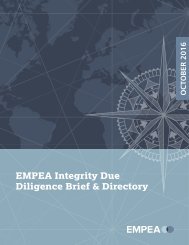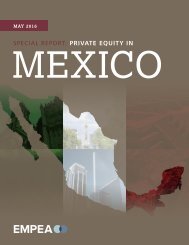You also want an ePaper? Increase the reach of your titles
YUMPU automatically turns print PDFs into web optimized ePapers that Google loves.
Business Environment<br />
Instrumental Factor Source Website<br />
Banking Industry Country Risk Assessments<br />
Standard & Poor’s<br />
http://img.en25.com/Web/<br />
StandardPoorsRatings/BICRA_<br />
Update_10_10_13.pdf<br />
R 2 = 0.391 Country Based Public Sector Influence = Medium Private Sector Influence = Medium<br />
This country-based ranking assesses the risk in 87 countries’ banking systems in accordance to their respective economic, regulatory and legal<br />
environment as well as the credit positions <strong>of</strong> the financial institutions that operate in this environment. Countries are classed according to their banking<br />
systems’ strengths and weaknesses into ten tiers. To obtain the rating S&P combines multiple factors that relate to the structure and performance<br />
<strong>of</strong> a country’s economy, the legal and regulatory infrastructure underpinning the financial system, and the structure and credit culture <strong>of</strong> the country’s<br />
banking industry itself. The score also reflects the quality and effectiveness <strong>of</strong> bank regulation and the track record <strong>of</strong> its central bank in financial<br />
crises management.<br />
http://www.eiu.com/public/thankyou_<br />
Business Environment<br />
EIU<br />
download.aspx?activity=download&<br />
campaignid=bizenviro2014<br />
R2 = 0.216 Country Based Public Sector Influence = High Private Sector Influence = Low<br />
This ranking covers 82 <strong>of</strong> the world’s more significant economies and measures their attractiveness to business. It is based on business surveys,<br />
quantitative data and expert assessments and reflects the general criteria used by businesses for the development <strong>of</strong> their strategic and investment<br />
location decisions. It is based on 91 indicators, the data for which is gathered by EIU’s global network <strong>of</strong> analysts. There are ten broad categories<br />
used: Political environment; Macroeconomic environment; Market opportunities; Policies towards free enterprise and competition; Foreign trade and<br />
exchange controls; Taxes; Financing; Labour market; and, Infrastructure.<br />
City GDP Figures<br />
Brookings Institute<br />
http://www.brookings.edu/research/<br />
interactives/global-metro-monitor-3<br />
R 2 = 0.179 City Based Public Sector Influence = Medium Private Sector Influence = Low<br />
This is a ranking <strong>of</strong> cities and / or their metropolitan areas by GDP. The list is based on projections and approximations as it is difficult to be exact<br />
when identifying GDP values. Depending on the methodology used, the rankings and values can vary and it is worth noting that some cities include<br />
larger urban areas which may result in lower per capita GDP estimates, whereas cities with a large portion <strong>of</strong> the working population living in metro<br />
areas, may have higher per capita GDP estimates as a result.<br />
Financial Secrecy Index Tax Justice Network http://www.financialsecrecyindex.com/<br />
R 2 = 0.320 Country Based Public Sector Influence = High Private Sector Influence = Low<br />
This index provides a measure <strong>of</strong> corruption, illicit financial flows and overall financial secrecy. The index highlights those places which give the<br />
greatest security, in terms <strong>of</strong> tax havens to tax refugees. Countries and territories are ranked according to the level <strong>of</strong> secrecy <strong>of</strong> their financial<br />
activities (derived from 15 financial secrecy indicators) combined with their scale (a weighting based on their share <strong>of</strong> the global market for <strong>of</strong>fshore<br />
financial services).<br />
The important financial secrecy indicators (KFSI) draw on data collected from an array <strong>of</strong> regulatory reports, legislation, regulation and news available.<br />
They encompass 15 different qualitative assessments split into four groups: Transparency <strong>of</strong> Beneficial Ownership; the availability <strong>of</strong> public trusts<br />
and foundations register, and <strong>of</strong> company beneficial ownership records; Corporate Transparency Regulation—publicly available company accounts<br />
and ownership; Efficiency <strong>of</strong> Tax & Financial Regulation—relates to whether the jurisdiction avoids promoting tax evasion, is fit for tax information<br />
exchange, allows cell companies and trusts with flee clauses and the overall tax administration efficiency; International Standards and Cooperation—<br />
relates to anti-money laundering (compliance with FATF), international transparency commitments, international judicial cooperation, bilateral treaties<br />
and participation in automatic information exchange.<br />
Institutional Effectiveness<br />
EIU<br />
http://www.economistinsights.com/<br />
countries-trade-investment/analysis/<br />
hot-spots/<br />
R 2 = 0.206 City Based Public Sector Influence = High Private Sector Influence = Low<br />
This is one <strong>of</strong> eight categories used in the Global Cities Competitiveness Index and contributes a weighting <strong>of</strong> 15% to the overall ranking. It comprises<br />
five sub-indices: Electoral process and pluralism, local government fiscal autonomy, taxation, rule <strong>of</strong> law and government effectiveness. These<br />
indicators favour cities which have stability <strong>of</strong> regulations, predictability and fairness <strong>of</strong> political processes and effectiveness <strong>of</strong> the system.<br />
Number <strong>of</strong> Greenfield Investments<br />
KPMG<br />
http://www.kpmg.com/FR/fr/<br />
IssuesAndInsights/ArticlesPublications/<br />
Documents/Observatoire-des-<br />
Investissements-Internationaux-<br />
principales-metropoles-mondiales-<br />
2013.pdf<br />
R 2 = 0.163 City Based Public Sector Influence = Low Private Sector Influence = Medium<br />
Designed to compare and benchmark the present and future attractiveness <strong>of</strong> centres as an investment destination. It endeavours to make a<br />
distinction between perceptions and reality <strong>of</strong> investment decision making. To measure perceptions, the survey polls a representative sample <strong>of</strong><br />
512 companies in 25 countries, which have international business settlements. To measure reality, the survey measures the number <strong>of</strong> published<br />
international “greenfield” investments that took place in a particular city; a greenfield investment occurs when a business launches a new activity in a<br />
particular location.<br />
142 |





